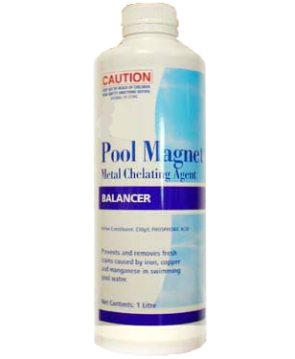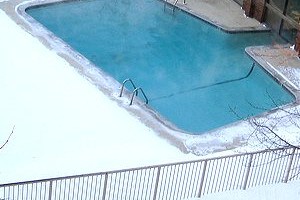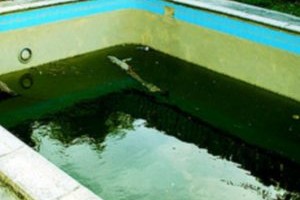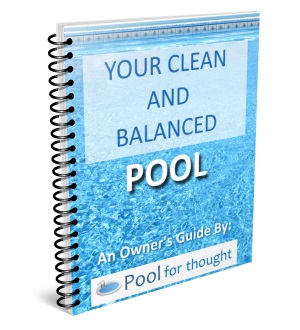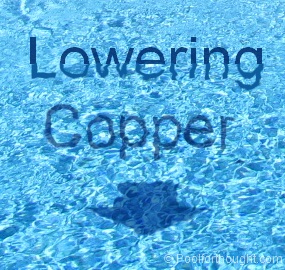
If you want to learn more about how copper finds its way in your pool, read Pool Water Copper – Causes and Concerns. If you need to know how to test your pool for copper, check out Testing Pool Copper.
Importance for your pool
Why is lowering swimming pool copper important?
It is important to keep the copper level as low as possible. If your water has copper in it, and you shock the pool or if your pool also happens to be out of balance with low pH, low total alkalinity, or low calcium hardness, then you risk oxidizing the copper present in the pool water. This oxidized copper can cause a number of problems, which I list below.
Why lower the pool copper level?
- Cloudy water. Water can only hold so much oxidized copper, before it reaches a saturation point. At this point, roughly 0.2 – 0.4 ppm (parts-per-million), any excess copper can begin to turn the water cloudy as it free-floats in the water.
- Copper can stain your pool. Eventually the copper finds its way to a solid surface where it builds up in a process called plating and can stain pool walls.
- Copper stained swimmers. Copper in the water can stain more than just the pool walls. People who have been in pools with excessive copper can end up with green-tinted hair. Their hair has been lightly plated with copper!
- Incorrect water balance test results. Pools with too many metals dissolved can throw off the calcium hardness test, causing a condition known as fading endpoint, resulting in a more complicated water test to first neutralize the metals present in the water test sample.
Why would i have copper in my pool?
There are plenty of ways copper can work its way into your swimming pool water:
- Your local water source.
- Using copper-based algaecides.
- Low pool pH, causing corrosion of copper surfaces.
- Improperly sized pool pipes and pump.
- Adding chlorine or other harsh chemicals to the pool filter basket.
- Using copper/zinc ionizers to sanitize the pool.
On adding chemicals to your pool
If you do regularly add copper-based algaecides to your pool, often used to fight persistent algae growth, you need to let the algaecide do its job, yet not let the copper level rise too much in your pool water. it’s best to work out a schedule consisting of something similar to the following:
- Add the algaecide per the product instructions.
- Test your copper level after one week of adding the algaecide, but before adding any more algaecide doses. You want to wait a week for the algaecide to do its job and kill the algae in the pool.
- If you have copper levels higher than 0.2 ppm, then add a copper sequestering agent or chelating agent.
- Retest the copper level in the water after 24 hours.
If you do find excessive copper in your pool water, then you need to add a copper sequestering or chelating agent. This binds with the copper molecules to bring them out of solution, where they can be vacuumed and filtered out of your pool water.
How to Lower your Swimming Pool Copper level
Lowering pool copper with a sequestering or chelating agent
Metals dissolved in pool water tend to turn the water slightly hazy, preventing the clear, sparkling effect. These chemicals are often branded as products that add sparkle to your water. If you think you may have copper in your pool water, here is how to lower your swimming pool copper level with a sequestering agent:
- Test and balance your chlorine, pH, total alkalinity, and calcium hardness levels to make sure your pool water is balanced and the proper level of chlorine is used. If you do have copper in your pool water, the sequestering and chelating agents will work better and more efficiently with balanced water. Once your water is balanced, your next step is to red the pool of copper.
- Test your pool water copper level. You need to see how high your copper level has become. If you are using a copper ionizer, then 0.2 ppm is okay.
- Purchase a bottle or container of sequestering or chelating agent. They most often come in liquids, but sometimes in powder form.
- Add the copper sequestering or chelating agent to the pool. You need to follow the directions on the product, as some instruct you to dilute the product first.
- Retest the pool water copper level after 24 hours.
- Re-test and balance your chlorine, pH, alkalinity, and calcium hardness levels to make sure your pool water is balanced and the proper level of chlorine is used. This will help prevent future corrosion from your equipment and if you do happen to get copper in the water again, balanced water will better keep the copper in solution so that a future copper test will catch it early before any staining occurs.
Tips on lowering your Swimming Pool copper level
[sc:ad_leaderboard_google] You can end up with copper in your pool if you use an algaecide that contains copper. These have no sequestering or chelating agents, so you need to reduce the copper level after one week by adding your own.Unless your water is continually corrosive, you should not have to test for cooper too often. In one summer season, for example, you should test copper at the start, a couple times mid-season, and one last time when the season is over.
If your pool walls are stained, then you may detect very little copper in your pool. All of the testable copper has found its way to the walls of your pool as stains.
Conclusion
It’s important to keep your copper level as low as possible and as close to zero as you can. Stained hair, fingernails, and pool surfaces can result in water with copper levels too high. With routine testing, balanced pool water, and occasional copper adjustment, you should rarely have trouble with copper in your swimming pool.
Sources:
- “Pool & Spa Water Chemistry, A Testing and Treatment Guide, Waterproof Edition, 2005. Taylor”
- “Wikipedia: Plating:”, https://en.wikipedia/wiki/Plating
